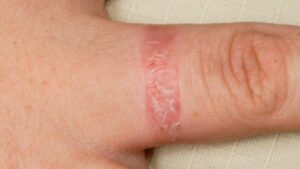Contact Dermatitis
What is contact dermatitis?

Contact dermatitis happens when the skin becomes irritated or inflamed after coming in contact with a substance that triggers an allergic reaction. It bears some of the same symptoms as the six other types of eczema. But unlike atopic dermatitis — the most common and difficult-to-treat form of eczema — it doesn’t run in families and isn’t linked to other allergic conditions such as hay fever or asthma.
There are two main types of contact dermatitis: irritant and allergic.
- Irritant contact dermatitis, which accounts for 80% of all contact dermatitis, doesn’t involve an allergic reaction by the immune system. Instead, it happens when skin cells are damaged by exposure to irritating substances, such as solvents, detergents, soaps, bleach or nickel-containing jewelry. Makeup, hair dye, nickel-containing scissors, belt buckles or clothes with metal snaps or zippers can also trigger reactions — as can over-washing hands with hot water and soap and wearing scratchy wool.
- Allergic contact dermatitis is a delayed allergic reaction that appears as a rash a day or two after skin is exposed to an allergen. Common examples are poison ivy, nail polish and poison oak. After exposure, the body generates a robust inflammatory reaction to the oils in the plant leading to an itchy rash within one to two days. Fragrances, nickel and the preservative thimerosal, which is found in some topical antibiotics, are also common causes of allergic contact dermatitis.
Who gets contact dermatitis and why?
Irritant contact dermatitis is common in people whose professions involve daily use of chemicals, such as mechanics, custodians, healthcare workers or hairstylists.
What are the symptoms of contact dermatitis?
Contact dermatitis causes a variety of skin problems, including itchy, crusting or scaly skin and lesions or vesicles in affected areas. More severe skin reactions include a hypersensitivity to the sun, an increased risk of sunburn and irritation from sunscreen. Oozing blisters can also occur in more severe cases.
In addition to skin problems, contact dermatitis can have a major impact on a person’s quality of life, including sleep disturbances, difficulty concentrating or performing duties at work and in school.
How is contact dermatitis treated?
Dermatologists commonly prescribe hydrocortisone and other steroids to treat symptoms of contact dermatitis, which can mimic several other skin conditions. It’s important to see a board-certified dermatologist to rule out other conditions such as psoriasis.
Topical steroids may resolve itching and other contact dermatitis symptoms, but if the rash is widespread, dermatologists may prescribe a short-term course of oral or injectable corticosteroids.
Preventing future outbreaks depends on pinpointing—and then avoiding—the irritant or allergen that triggers flares. Having a good skin care routine with the right moisturizers, lotions and other skin can products also prevents future flare-ups.
With irritant contact dermatitis, the trigger is usually easy to identify, as stinging, pain or discomfort usually happens within minutes of contact.
For allergic contact dermatitis, knowing what to avoid often requires allergy testing. The most effective in-office procedure is called patch testing. This is when the doctor applies patches with small amounts of various allergens to the patient’s arm or back and then evaluates skin after about 48 hours. Antihistamines or other allergy treatments may be prescribed.
Dermatologists who are members of the American Contact Dermatitis Society (ACDS) are recognized experts in contact dermatitis and patch testing.
What do the ecz-perts have to say?
According to Dr. Jeff Yu, a dermatologist specializing in allergic contact dermatitis and occupational dermatitis in adults and children at Massachusetts General Hospital in Boston, “The more people are exposed to an allergen the more likely they are to develop contact dermatitis in response to that allergen. For example, people with body piercings have a higher likelihood of developing contact dermatitis in response to nickel compared with people who do not have them.”
Patients often think food is a contact allergy culprit, but Yu said what we eat is rarely the culprit. “In reality, the cause is almost always contact with something in your topical products, whether this is shampoo, make-up remover, perfume, essential oil diffusers, paints, glues or a topical antibiotic.”
Common allergens and irritants can be elusive to track down, but ongoing research in the fields of dermatology and immunology are increasing our knowledge of how these allergens can affect your skin. Read more to learn how one NEA Ambassador finally tracked down her nickel allergy.
How do you get rid of contact dermatitis?
Contact dermatitis often goes away on its own, but that doesn’t mean you should try and address the symptoms. There are a variety of prescribed, over-the-counter, and at-home remedies than can help manage your symptoms.
Should you put lotion on contact dermatitis?
This depends on the type of lotion and how your body has reacted to similar products in the past. A gentle, NEA-approved lotion may help, but don’t just use any lotion on contact dermatitis. In fact the cause of contact dermatitis is often contact with an irritant in a topical product.
What creams and emollients are recommended for contact dermatitis?
Be sure to consider patch testing before you use any over-the-counter creams or emollients to treat symptoms of contact dermatitis in case your rash is a result of allergic contact dermatitis. After you’ve ruled out allergens, talk with your dermatologist about any lingering skin irritation, hives, blisters, skin infections, or possible photocontact dermatitis, before making any decision about using creams and lotions on your contact dermatitis. Consider using the NEA Product Directory to search for the product that works best for your individual skincare needs.
How do you avoid allergic contact dermatitis in the future?
The surest way to avoid allergic contact dermatitis in the future, after experiencing an outbreak of itchy skin, is to speak with your dermatologist, allergist, or immunologist about the environment in which you were exposed to the potential allergen and avoid that allergen in the future. For poison ivy or poison oak, for instance, describe where you could possibly have become exposed to either plant to determine if you might have encountered the allergen in a setting that you’re likely to encounter it again (such as a local hiking trail or park); this will help you make a plan to locate and identify the possible trigger in your environment; in some instances, the trigger may be an animal, such as a cat or a dog.
Can animals trigger allergic contact dermatitis?
The short answer is yes. Animals, such as cats and dogs, can trigger an allergic reaction via the dander their skin flakes off. Many people who are allergic to animals mistakenly believe it is the fur or hair of the animal that is most important to avoid. However, most allergies come from the flakes of dander that come from an animal’s skin. For some people with allergies to animals, consider coordinating preventative care with an allergist to avoid hives, itchy skin, a skin rash, or other symptoms that flare-up after coming in contact with an animal known to cause your skin to flare. To read more information about dogs can trigger contact dermatitis read here.
As always, every case of eczema is unique and requires a shared conversation between the healthcare provider and the patient. People with eczema are the experts of their own bodies and known their own symptoms better than anyone; bringing that knowledge about your history of allergens and triggers can facilitate your conversation with a doctor about what possibly caused your contact dermatitis flare-up and how to avoid encountering the irritant in the future.
Is it possible for a child to experience contact dermatitis?
Yes, environmental allergies can and do impact young children, including babies. Eczema can begin as early as a few weeks of age and can then progress, if left untreated, into a sequence of conditions known as the Atopic Triad (or the Atopic March), where asthma and food allergies sometimes follow the initial diagnosis of eczema. Read more about the Atopic March here.

